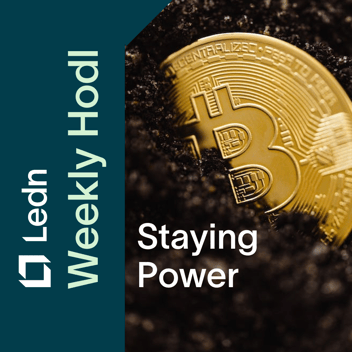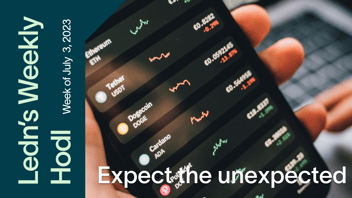Weekly Hodl: Inflation waves
.png?width=1080&height=1080&name=IG%20BEC%20(12).png)
Ledn’s Weekly Hodl: Inflation Waves [and how to surf them]
Week of Monday July 24th
Start earning up to 9% APY on your crypto with a Ledn Savings Account.
Bitcoin Market Analysis
Last week bitcoin closed its 5th consecutive week above $30k on thinly traded volume. From a technical standpoint, this bodes well for a potential continuation of the rally. At the time of writing, bitcoin is bouncing around $29,500 as markets react to the recent decision from the Federal Reserve to increase interest rates to 5.50%.
Markets are cheering the Fed’s statement that it “may” take a pause from raising rates in September, depending on the data. Inflation data has been coming in soft over the last few months, and the market could be extrapolating that it will get a break from rate hikes in September. This could allow markets to move higher on the back of “animal spirits” over the next month.
Coincidentally, there are potential wildcards for bitcoin before the next Fed meeting. The biggest ones being the Bitcoin Spot ETF decisions. The second deadline for a decision on the ARK 21 Shares application is August 13th – and the first deadline for the first decision on Blackrock’s application is September 2nd, 2023 - both of which are happening ahead of the Fed’s next meeting on September 20th. We’ll be watching the developments on this front closely.
Our Weekly Essay: Inflation waves and how to surf them
Venezuela taught me to “unlearn” most of what I read in economics books. In most economics books, you are told that debt is bad. You are told that assets depreciate in value over time. That you should put away a little bit of your fiat paycheck into a bank account every month to save for a rainy day.
I saw many who followed the textbooks sink into poverty. And those who were seemingly ignoring the textbooks thrive. It made me question everything, and re-learn how money and debt really work in the process. Little did I know that the painful lessons I learned about inflation would come in handy for the rest of my life.
As many living Americans and Canadians are just finding out, inflation is not limited to “the global south”. In fact, all large human civilizations had severe inflation problems - dating back to babylon.
One of my biggest takeaways from living through hyperinflation was this: inflation comes in waves.
Waves of Inflation
Much has been written as to why inflation comes in waves. As you know, our preference here is to simplify seemingly complex concepts - so we’re going to break it down in the simplest way we can.
As we have all witnessed through COVID, the major driver of inflation is a large jump in the money supply, which then takes its time to permeate through the economy and reach equilibrium again.
How wave 1 starts: The Demand Shock
In response to an economic event, a government or central bank will print the money it needs to re-stimulate the economy. This puts money in people’s pockets and creates a boost in demand.
Because the supply of things that can be bought is largely fixed (companies can’t produce more cars or build more widgets overnight), this creates upward pressure on prices.
Typically this happens in both goods and services, but because of the COVID lockdowns, a lot of the pressure went to assets and capital goods first (houses, cars, large ticket purchases). These purchases are much more sensitive to interest rates, as many of them are purchased via financing.
As the economy has reopened, the pressure has now transitioned to services, like travel, hotels, and restaurants. People had not been able to travel or eat out in years - and they still have accumulated savings. Now we’re seen inflation permeate through both assets, capital goods and services.
As a result from this new demand, businesses have to adjust their labour force - and because of COVID, many companies are rebuilding their supply-chains on-shore, which drives even higher pressure on North American wages. This is why we continue to see record low unemployment in the U.S.
How wave 1 ends: The Central Bank hammer
As the Central Bank sees their newly printed money drive the price of everything higher, they start taking action to keep inflation from going out of control. The primary way of doing this is increasing interest rates - this typically slows down sales of all assets that require financing.
As we’ve seen, the Fed has embarked on a record-setting interest rate hike bender, taking rates from 0.25% to 5.50% in a matter of months. The most aggressive rate hike in Fed history. Not surprisingly, asset prices have stopped rising, and in some cases are showing slight negative growth (see U.S. home prices).
Higher interest rates are also having an impact in the “street” economy. The Consumer Price Index came in at 4% for June, if we exclude gasoline prices. For context, the inflation rate in June 2022 was 7.1%.
And of course, politicians are already doing victory laps…
How wave 2 starts: The great salary adjustment
Typically, what the Central Bank wants to see when it raises interest rates is a change in the dynamic that causes inflation. It wants people to spend less. This means, lower asset prices (real estate, capital markets), and higher unemployment.
What we are seeing is quite the opposite:
The median sales price of U.S. homes has only dropped by 13% from its peak..
And the S&P 500 is within 8% of its all-time high. Most people’s portfolios are nearly intact from their post-pandemic highs.
And unemployment in the U.S. is at record lows
This sets the stage for a great adjustment - that of worker salaries. At a macro level, we’ve seen average wages keep up with the pace of inflation.
Which explains why the economy has been able to withstand increasingly high prices: wages have been increasing proportionately.
However, the current situation has given workers a lot of bargaining power, and they are starting to use it.
The above are examples of recently completed negotiations at a union level. And there is a wave of strikes threatening western economies this summer:
Canada:
The U.K:
The U.S.:
To put things in perspective, the number of workers that could strike this summer is almost 800k, almost 4X the number of workers in 2022.
With unemployment at record lows, chances are that the union negotiators will be successful in negotiating higher wages.
Higher wages means that the economy can withstand higher prices, and it also means that companies must pass on the higher costs to the consumer - the result? More inflation.
How wave 2 ends: Even more hammering from the Central Bank
In “the best scenario”, Central Banks will try to exert so much pain in the economy, that they will force people and companies on the margins into insolvency. They will also deliberately try to pause any new printing or injecting money into the economy. They will literally try to engineer hardship.
In other words, the Central Bank will likely continue increasing interest rates until they can bring inflation down, wage growth down, and unemployment up.
How wave 3 starts: The need to be liked
Nobody wants to be in charge when the task at hand is to engineer hardship. This is a difficult task when your job is to get reelected. Given where we are in the U.S. presidential cycle, chances are that by early next year, the government will be a lot less willing to engineer hardship. They can bypass the impacts of high interest rates by pumping more money into the economy. And this is exactly what they are planning to do, according to the U.S. congressional budget office.
For context, the U.S. ran a fiscal deficit of -$3.1 Trillion in 2020. For 2023, they are expected to run a deficit of -$1.5 Trillion according to the congressional budget office. That means that they are still pumping $1.5 Trillion into the economy - which can keep people feeling wealthy, and affording more expensive things.
Closing Thoughts:
The FIAT system is like the ocean - inflation, like waves, never stops. There can be big waves, small waves, and periods of calm, but the next wave is always a matter of time.
Increasing the money supply will always make its way into the economy in the form of higher prices.
The best way to protect yourself from the depreciating value of FIAT money units, is to ensure you’re earning a rate that is compensating value erosion through inflation - like with Ledn’s USDC Savings Account, or to swap those units of fiat for an asset that cannot be arbitrarily printed, like Bitcoin. Gold and real estate have also been good historical hedges.
This is why we hodl.
Notice for Canadian Residents: As of January 4, 2023, Canadian clients will no longer be able to take out new B2X loans.
As of February 1, 2023, Canadian clients will no longer be able to open a new BTC or USDC Savings Account, deposit BTC or USDC to existing Savings Accounts or earn yield on any existing BTC or USDC Savings Account balances.
Notice for U.S. Residents: Effective March 1, 2023, U.S. clients will not earn interest on any BTC and/or USDC balance in their Savings Accounts and/or Legacy Savings Accounts.
This article is intended for general information, educational and discussion purposes only, it is not an offer, inducement or solicitation of any kind, and is not to be relied upon as constituting legal, financial, investment, tax or other professional advice. This article is not directed to, and the information contained herein is not intended for distribution to, or use by, any person or entity in any jurisdiction or country where such distribution, publication, availability or use would be contrary to law or regulation or prohibited by any reason whatsoever or that would subject Ledn and/or its affiliates to any registration or licensing requirement. This article is expressly not for distribution or dissemination in, and no Ledn product or service is being marketed or offered to residents of, the European Union, the United Kingdom, the United States of America or any jurisdiction in Canada, and such product or service may only be marketed or offered in such jurisdictions pursuant to applicable laws or reliance on regulatory exemptions. A professional advisor should be consulted regarding your specific situation. Digital assets are highly volatile and risky, are not legal tender, and are not backed by the government. The information contained in this publication has been obtained from sources that we believe to be reliable, however we do not represent or warrant that such information is accurate or complete. Past performance and forecasts are not a reliable indicator of future performance. Any opinions or estimates expressed herein are subject to change without notice. This article may contain views or opinions of the author that do not necessarily reflect the opinions, standards or policies of Ledn. We expressly disclaim all liability and all warranties of accuracy, completeness, merchantability or fitness for a particular purpose with respect to this article/communication. Read our Disclaimers at https://ledn.io/legal/disclaimers



